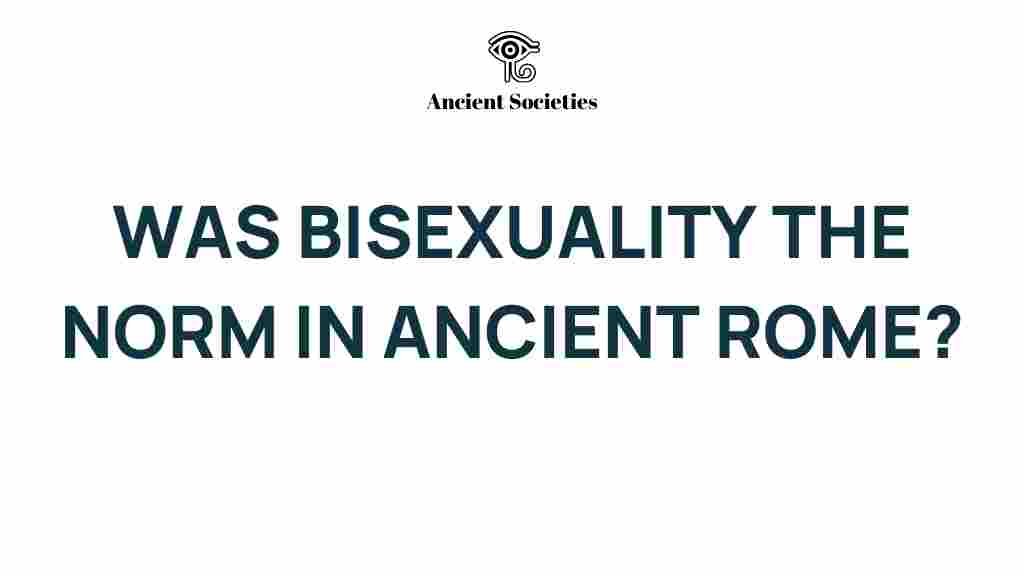Was Bisexuality the Unwritten Rule in Ancient Rome?
Understanding the complexities of sexuality in Ancient Rome reveals a fascinating aspect of the Roman Empire’s culture and social norms. Bisexuality, as a significant part of the sexual landscape, challenges our contemporary perceptions of relationships and gender. This article explores how bisexuality was not just tolerated but may have been an unwritten rule in Ancient Rome, supported by historical evidence and archaeological findings.
The Sexual Landscape of Ancient Rome
The Roman Empire was a melting pot of cultures, ideas, and practices. Sexuality in Ancient Rome was multifaceted, influenced by Greek traditions, local customs, and evolving social norms. The Romans had a pragmatic approach to sexuality, often prioritizing social status and power over personal attraction or emotional connection.
- Fluidity in Gender Roles: In Ancient Rome, the rigidity of modern gender roles was less pronounced. Individuals often engaged in relationships that crossed traditional boundaries.
- Power Dynamics: Sexual relationships were often about dominance and submission, rather than the gender of the partner involved.
- Public vs. Private Life: Many Romans maintained a public persona that adhered to societal expectations while exploring their sexuality privately.
Archaeological Evidence of Bisexuality
Archaeological findings provide insight into the sexual practices of the Romans. Artefacts, inscriptions, and artworks often depict a range of sexual activities, including same-sex relationships. Some key evidence includes:
- Art and Sculpture: Many Roman sculptures and frescoes illustrate same-sex couples, indicating acceptance of such relationships.
- Literary Texts: Writers like Juvenal and Martial referenced bisexual relationships, often with humor or satire, shedding light on societal attitudes.
- Inscriptions: Tomb inscriptions sometimes celebrate same-sex love, which suggests a degree of societal acceptance.
Social Norms Surrounding Relationships
In Ancient Rome, social norms regarding relationships were complex. While heterosexual marriage was the ideal, bisexuality was not uncommon, especially among the elite classes. Understanding these norms helps contextualize how bisexuality thrived in this ancient society.
- Marriage and Procreation: Marriage was often seen as a social contract primarily for procreation and alliances, allowing individuals to seek pleasure outside of it.
- Elite Male Relationships: Wealthy Roman men often took younger male lovers, reflecting a societal acceptance of bisexuality among the powerful.
- Women’s Roles: Women’s sexual autonomy was limited, but some evidence suggests that they engaged in same-sex relationships, albeit less publicly.
Historical Context of Bisexuality in Rome
To understand bisexuality in Ancient Rome, one must consider the broader historical context. The Romans inherited many sexual customs from the Greeks, who had a more open attitude toward same-sex relationships. Key historical elements include:
- Greek Influence: Greek philosophies celebrated bisexuality, which significantly influenced Roman culture.
- Military Culture: The military was a space where bonds between men often included sexual elements, which reinforced the idea of bisexuality.
- Philosophical Views: Philosophers like Plato discussed love in various forms, including same-sex love, contributing to a broader acceptance of bisexual relationships.
Modern Interpretations and Misconceptions
Modern interpretations of ancient sexuality often fall into the trap of applying contemporary labels retrospectively. Understanding bisexuality in Ancient Rome requires a nuanced approach:
- Labels vs. Practices: The modern concept of bisexuality as a distinct identity did not exist; instead, sexual practices transcended labels.
- Contextual Understanding: It’s essential to understand relationships within their historical context rather than judging them by today’s standards.
- Archaeological Limitations: Interpretations of archaeological evidence can be subjective and need to account for cultural differences.
Challenges in Understanding Ancient Roman Sexuality
Despite the wealth of evidence, several challenges complicate our understanding of bisexuality in Ancient Rome:
- Incomplete Records: Much of the historical record is fragmented, and many voices, particularly those of women, are missing.
- Changing Norms: Social norms and practices evolved over time, making it difficult to draw general conclusions across the entire Roman Empire.
- Interpretive Bias: Modern scholars may project contemporary biases onto ancient texts and artefacts, skewing interpretations.
Step-by-Step Analysis of Bisexuality in Ancient Rome
To analyze the role of bisexuality in Ancient Rome, consider this step-by-step approach:
- Research Historical Texts: Examine works by Roman authors to gain insight into societal attitudes toward sexuality.
- Analyze Archaeological Findings: Investigate artefacts and inscriptions that reveal sexual practices and relationships.
- Contextualize Within Society: Understand the role of class, gender, and power dynamics in shaping sexual norms.
- Compare with Other Cultures: Explore how other ancient cultures viewed bisexuality to provide a broader comparative context.
- Consider Modern Implications: Reflect on how our understanding of bisexuality in the past informs contemporary discussions about sexuality.
Troubleshooting Misconceptions About Ancient Sexuality
To better understand and communicate the realities of bisexuality in Ancient Rome, consider these troubleshooting tips:
- Avoid Anachronism: Resist the urge to apply modern sexual identities to ancient practices.
- Emphasize Nuance: Acknowledge that sexuality was complex and varied widely among different groups within Roman society.
- Encourage Open Discussion: Foster conversations that respect the diversity of sexual experiences in the past and present.
Conclusion
In conclusion, bisexuality in Ancient Rome was more than mere tolerance; it was a significant aspect of the Empire’s complex sexual culture. The interplay of social norms, power dynamics, and cultural influences shaped how relationships were formed and understood. By exploring the historical and archaeological evidence, we gain valuable insight into the multifaceted nature of sexuality in the Roman Empire.
As we reflect on these ancient practices, it is essential to approach the subject with an open mind and a willingness to challenge contemporary assumptions about relationships and gender. Understanding the past enriches our comprehension of modern sexuality and encourages a more inclusive dialogue about identity and relationships.
For more insights into the history of sexuality, you can explore this resource. Additionally, for a deeper dive into Roman culture, check out this article.
This article is in the category History and created by AncientSocieties Team
